
BY HEATHER ROBINSON OF TIGER TOE COLLECTIVE, SFAI EQUAL JUSTICE RESIDENT
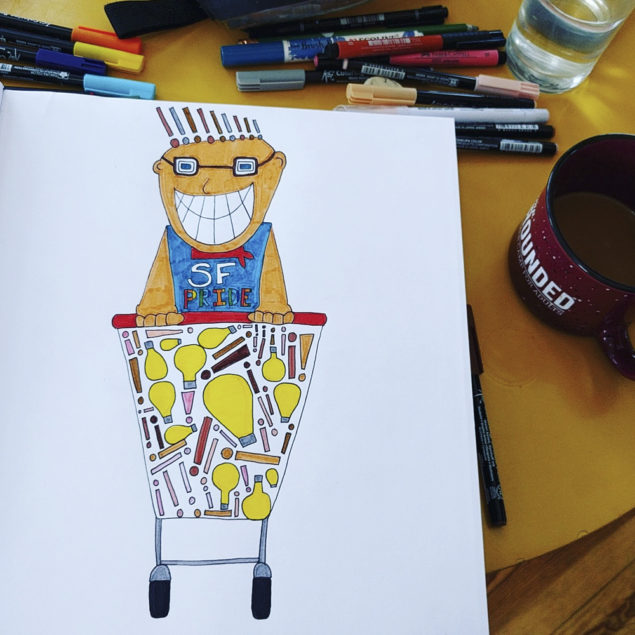
Self portrait of this artist before her first residency.
Before I left for my first artist residency at the Santa Fe Art Institute, I Googled what to expect. I needed to find out how to deal with all the anxiety that was coming up for me. It was way more than was going to fit into the overhead bin of my airplane. If having the time and space to finally fully dedicate myself to my creative practice was what I had always wanted, why was I quivering like a Jello sculpture on a flatbed truck going 80 miles an hour?
Well, maybe it was because it’s only been the last few minutes that I’ve been able to identify as an artist, without giving myself some major side-eye. I have been a writer, a student of physical culture, and a physical trainer for years, but I have only just started drawing in the last few. My mission (along with my creative partner Rebecca Berdel) was to combine all three pursuits into something the world has never seen and sorely needs: a kind and funny alternative to the horror that is the mainstream fitness industry.
It was exciting to think of all the other creative changemakers packing their bags, and descending on Santa Fe to get serious about their own projects as well. I imagined a training montage of artists gathering up their supplies and folding their paint-splattered pants, while listening to some kind of upbeat alternative track. We were on our way!
What is an artist residency exactly?
When I told my friends and family I had been awarded my first artist residency they were universally supportive and confused. Since then they have referred to my experience as an internship, fellowship, retreat, and an anti-capitalistic, creative, party-town (okay, I made the last one up). Turns out-artist residencies have elements of all these things, but they are also unique animals, all their own.
Residencies were started over a hundred years ago to give creative people of all disciplines time, support, and space away from their usual everyday obligations and their daily grind. They vary widely in the type of people they host-some focus on visual arts or writing while others have a multidisciplinary approach; the amount of structure they provide-some require work to be exhibited and documented while others ask nothing of their residents, and in the amount of time they last-from two weeks to up to one year. All offer some kind of support, through stipends, accommodations, food, transportation and other resources. Some take place deep in the wilderness and others in the heart of big cities. A big part of many residencies is building community among artists as well as the surrounding community.
The Santa Fe Art Institute’s program is unique in many ways, but especially in its ambition-supporting nearly 100 people over the course of the year-and true dedication to an interdisciplinary approach. My cohort included sculptors, lawyers, textile makers, writers, architects and so much more.

Still from Tennis Family Campout Animation.
Nervousness with a quivering cherry on top
The first day of my residency began with an orientation with the 10 other artists in my cohort, including round robin introductions where we would attempt to sum up our existence in a few pithy sentences. I sat in a puddle of chilly sweat awaiting my turn, getting more intimidated by the moment. Everyone was doing such important and interesting work. How would my little project compare? Would they take me seriously? Could I take myself seriously? What were unspoken the rules of this new world?
I later learned that one of the other artists in the group writes sci-fi graphic novels, which is exactly what my new art planet felt like. On the first day I was a goofy Earthling with no idea about the gravity, weather, or the number of eyes/tentacles that were popular among the cool kids. There were lots of phenomena, expected and not, that I would learn about in the coming weeks. At times I would still feel like a stranger in a strange land, but often I would feel like I belonged in this Star Wars space bar and that I was appreciated for the unique number of eyes and tentacles that I brought to the table. Plus free coffee and peanut butter!
9 Things I Learned at My First Artist’s Residency
1. Time is a rubber band and a hammer
This artist residency was supposed to be oasis from the complicated relationship I-and most other people it seems-have with time. In the usual framing, time is like a neglectful lover: never giving us enough of what we need. At an artist residency, time comes crawling back on its hands and knees, carrying roses and planning elaborate dates. For me this was an opportunity to untangle and better understand my relationship with the ticking clock, which had often been based on scarcity and a whole lot of complaining.
I quickly learned that this blessing can also feel like a curse. For so long I’d been wishing and hoping for more time and energy to devote to my projects and now here it was! So why was I tied up in a psychological pretzel? I came to find that like any windfall resource the gift of time in an artist residency must be managed. And, in general, humans tend to not manage sudden windfalls of anything well (see: lottery winners). Even as we often rail against our usually busy schedules, they also give our lives structure and stability. An artist residency challenged me to reject this usual foundation and instead use my instincts, skills and creativity to devise my daily scaffold. I had won the time lottery. How would I manage this windfall?

Just a bit excited about our studio space at SFAI.
2. Allowances are paid in weirdness
One of the best parts of SFAI is the communal areas where you get to connect with other artists and talk about your daily struggles and triumphs. I was pleasantly surprised that there seemed to be very little idle chit-chat and people really got down to interesting business. They were curious, supportive, and accepting. This was not what I was used to. For example when I had a rough day and brought a stuffed animal to the communal dinner table to dine with me, nobody called me a weirdo. They did ask what my animals name was and what it liked to eat (Otter likes French fries). People tended to ask interested questions about what you do, instead of judging you for it, which is very different than my experience of the non-art residency, “real world.” I’m not saying an artist residency is a judgement-free zone, just that people tend to try and lead with curiosity and respect for different approaches to making breakfast and creating art. What a relief.
3. Inspiration Nation
There is so much power and inspiration in being surrounded by other people who have dedicated their lives to creativity, artistic practice, and making the world a better place. Most people do not make this difficult and often ridiculously challenging choice. I did my best to absorb this into my marrow so that I could hold on to that feeling.
I also learned that even established artists, especially the interdisciplinary kind who are always trying completely new things, don’t know what they’re doing most of the time. I had the silly and un-investigated belief that once you’re a “real” artist you’re really good at making whatever you want to make. This turned out to be completely untrue. The artists around me were all struggling to learn new skills and tackle challenging projects that they had never tried before. Turns out being an artist is not just about having interesting ideas and executing them skillfully, it’s about learning to be comfortable with lots of struggle, learning, and failure. It’s about continually facing the painful gap between your idea and your skill set and figuring out a way to bridge it. Watching other artists bridge these gaps was very inspiring.
4. Respect your pace and process
A very kind and experienced artist who had done many residencies told me not to put too much pressure on myself regarding outcome. I sure wish I had been able to really hear this message, because of course I turned myself into a human diamond. Chatting with other first time residents helped me see that this was very common. Turns out most of us have an inflated idea of what they will be able to produce in the allotted time period. We do a crazy equation in our heads that is something like: Days at residency x 10 hours per day = Great American novel/sculpture/play/etc. Most of us found out the hard way that a person still needs to rest, recreate, do their laundry, fill their artist chow bowl and have a few nervous breakdowns (which are really hard to fit into your regular schedule). I tried to keep in mind that research says the average creative person is fried for the day after only 6 hours of intense focus and to be gentle with myself, but often I would forget. Sometimes renaming things helps me to give myself a break. Sleep became “subconscious art making.” Exploring the local area is “material for future art.” Coffee is “art making juice.” You get the idea.
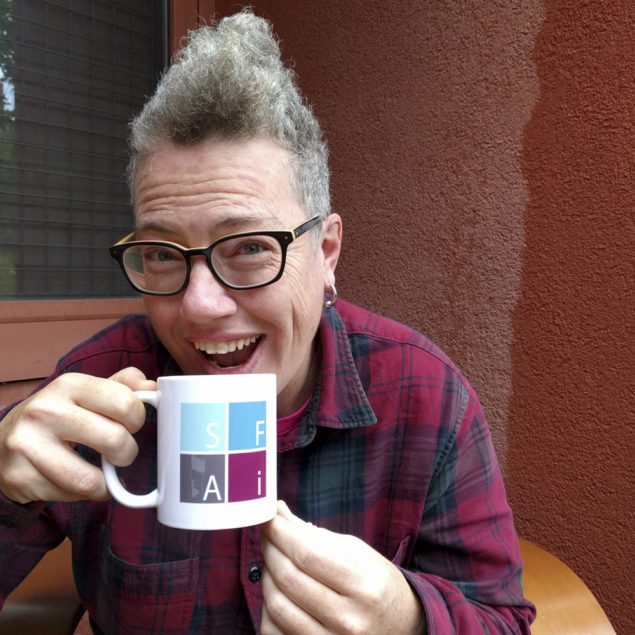
Drinking art making juice on my SFAI porch.
5. Stay true to yourself
While at the residency I came face to face with a lot of preconceived notions of what I thought a “real” artist was: tortured, drunk, wearing a lot of black and using the term “intersectional” a lot, just about summed it up. If I’m kinda silly, pretty frequently drunk, wear mostly orange and pink and like to sit on sectional couches whenever possible- how can I be a real artist? The diversity of the residents at SFAI helped me to see that artists are a kaleidoscope of diversity. There is no one right way to be an artist and you don’t have to wear a beret unironically or ironically. For example, I’m definitely bouncier and gigglier than the average artist, and don’t do the morose, tortured part that well (though I have my days). I’m still figuring out which of the unspoken “art rules” I like. Taking yourself and your work seriously: yes. Taking yourself and your work way too seriously: No thanks.
6. Fancy art words I have learned
Practice, process, interdisciplinary shenanigans. I didn’t go to art school and there is a lot of the culture that is new to me. At the first day orientation the director kept talking about “our practice” and some of the other artists mentioned “their practice” when talking about why they were here and what they wanted to do. I had really only heard the term used in the concept of sport and occasionally mindfulness. Though at first it felt pretentious, I liked using it for what I was trying to do at my first residency as well. My definition of practice is doing something on a regular basis with clear intention and the goal of gradual improvement. Practice is setting aside time and energy for something with an unsure outcome. The discipline and process has to be its own reward or it’s not going to be worth it. Once I got used to saying “practice” without giggling, I began to think of mine as a serious discipline to always be developing.
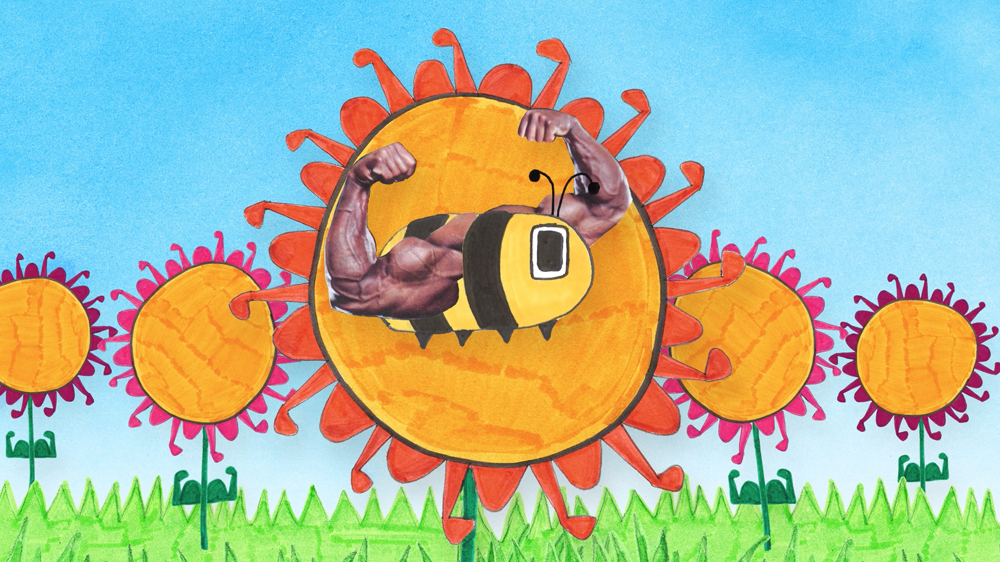
Still from Muscle Garden animation.
7. Is there a vaccination for imposter syndrome?
Imposter syndrome is an insidious virus that there is no vaccination for and it is pretty contagious at a residency, when you are surrounded by a lot of other artists with CV’s longer than the Rose Parade. Its pretty easy to feel like a fraud and that you don’t deserve to call yourself an artist, especially after a bad day of making awkward things. Kind, experienced artists told me that this would be a lifelong struggle, unless I decide to go to law school instead. Therapy and wearing paint stained clothing can help somewhat. Also, realizing that most other sensitive, creative people are feeling the same thing can ease the burden. One of the great things about an artist residency is that you’re not alone in your tortured existential crisis. There were people all around me to reassure me through the struggle, which equaled much less torture.
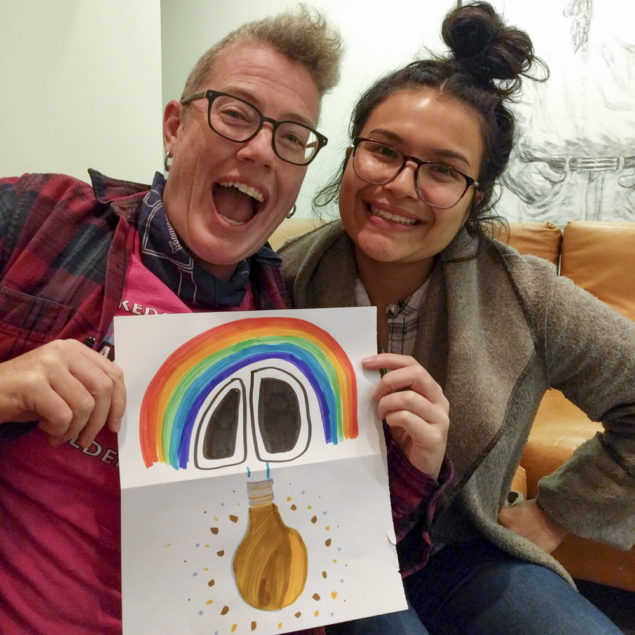
Playing art game with fellow resident Alicia Inez Guzmán.
8. Existential Crisis, Party of 1
There were bad days. Days when I pulled my hair out and wondered if human hair collages might be a better idea than the schlock I’d been making. Today in real grownup land someone rewired a house, someone filled in teeth cavities, someone taught a small human about the letter “P.” On bad days devoting your life to making strange things can make you wonder if you’re wasting it. Other days I knew that being a dentist would be five times as bad and that I would probably end up making little filling pictures in people’s teeth and making collages out of all the Highlights magazines in the lobby. As someone who can’t even fold their laundry the same way twice, I know there are many respectable professions that are not for me and I’m doing the world a favor by not doing them badly. Who wants a day-dreamy firefighter or a highly sensitive mail carrier who anthropomorphizes junk mail and feels sorry for it?
Conclusion
And my most important lesson was to be grateful for this opportunity. At least everyday, if not more often. I learned tons, grew a lot, met so many interesting, creative people and ate a lot of chiles (they’re good for writer’s block). It was a magical time off the grinding, capitalistic grid to heal, grow, rest, recharge, get weird, have fun and make wonderful things. I can’t wait to do it again.

Residency Program Manager Toni Gentilli and Tiger Toe celebrate a successful residency in the SFAI courtyard.

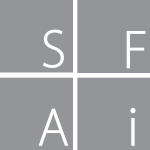 © Santa Fe Art Institute / Santa Fe, New Mexico /
© Santa Fe Art Institute / Santa Fe, New Mexico /